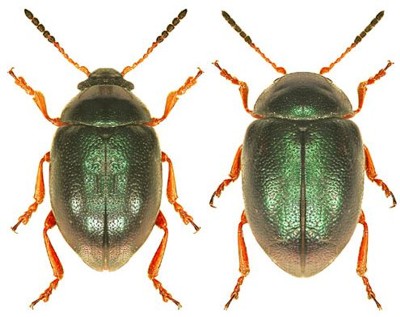Pests
Colaphus hoefti (Men.) - East Mustard Beetle
Systematic position.
Class Insecta, order Coleoptera, family Chrysomelidae, genus Colaphus Dahl. Sometimes it is treated as subspecies of Colaphus sophiae Schall., differing from the latter in reddish femora, sometimes darkened in basal part.Synonyms.
Colaspis hoeftii Men.Biological group.
Pest of cruciferous crops: mustard, turnip, cabbage, rape, horseradish, radish.Morphology and biology.
Body length is 3.5-6.0 mm. Body convex, blue or green with reddish apical part of elytra. Head is broad, frons with 2 pits near antennal base. Mandibles are long and angularly curved with 2 apical denticles. 1st-6th antennal segments are light-reddish, the 7-11th segments are thickened. Pronotum is short and broad with rounded basal margin, somewhat narrowed toward apical margin; disc with tiny irregular punctation. Scutellum is smooth, wide-triangular, with rounded apex. Elytra with humeral calluses somewhat broader than pronotum, the last third having distinctly narrowed distad. Elytral disc is shining and cross-wrinkled. Tibiae broadened distad, 3rd tarsal segment weakly emarginated. Legs are completely reddish, sometimes with darkened femoral base. Female lays batches of 10-20 eggs in soil or on plants. Fertility is about 200-300 eggs. Oviposition continues before death of adults in July. Egg is elongate-oval, yellowish; its length is about 1 mm. Embryogenesis lasts 4-5 days, larval development 15-18, pupal lasts 7-11 days. Hatching larva is brown and densely covered with thickened apically hairs. Body length of mature larvae is about 8-9 mm. They are brown-bronzed with black head capsule, and dirty-yellow abdomen.Distribution.
South of the European part of Russia (perhaps only eastward of Dnepr River valley), the Caucasus, South of Western Siberia, Middle Asia and Kazakhstan.Ecology.
Usually monovoltine species. It hibernates in adult stage in the surface soil layer. Overwintered beetles appear in March-July and at first feed mainly on cruciferous weeds (Brassica, Lepidium, Malcolmia, Raphanus, Sisymbrium). Later adults migrate to fields with mustard in stage 3-4 leaves and begin mating and ovipositing. Hatching larvae consume leaves, apical part of stems and inflorescences. Most of larvae occur in stages of shooting and inflorescence. Pupation occurs inside a soil cradle at a depth to 5-6 cm. After emergence young beetles usually do not leave the cradles until spring. Some of them appear on the surface soon after emergence but do not damage agricultural plants.Economic significance.
The pest damages in adult and larval stages. Major damage occurs in steppe zone of the Southeastern European part of Russia. Beetles become more numerous after drought season and in arid regions. They damage cabbage sprouts in greenhouses too. Control measures include using fertilizations for the acceleration of seedling development, utilization of plant remainders in early spring or after harvesting, and deep autumn plowing. Insecticide treatment is necessary at high adult abundance.Reference citations:
Bienkowski A. 2004. Leaf-beetles (Coleoptera: Chrysomelidae) of the Eastern Europe. New Key to subfamilies, genera and species. Moscow: Mikron-Print. 278 p.Borowiec L. 2008. Colaphus hoefti (Menetries. 1832). Uniwersytet Wroclawski. http://www.biol.uni.wroc.pl/cassidae/European%20Chrysomelidae/colaphus%20hoefti.htm
Brovdii V.M. 1974. Family Chrysomelidae. In: Vasil.ev V.P., ed. Pests of agricultural crops and forest plantations. V. 2. Arthropods. Kiev: Urozhai, p. 49-88 (in Russian).
Dobrovol'skii B.V. 1951. Harmful beetles. Rostov-na-Donu: Rostizdat. 455 p. (in Russian).
Dubeshko L.N. & Medvedev L.N. 1989. Ecology of leaf beetles of Siberia and Far East. Irkutsk: Izd. Irkutskogo universiteta. 224 p. (in Russian).
Grivanov K.P. & Zakharov L.Z. 1958. Pests of agricultural crops on the SE of the European part of Russia. Saratov: Saratovskoe knizhnoe izdat. 236 p. (in Russian).
Gussakovskii V.V. 1949. Order Coleoptera. In: Pavlovskii E.N. & Shtakel'berg A.A., eds. Pest Animals of Middle Asia (handbook). Moscow & Leningrad: AN SSSR. P. 57-109. (in Russian).
Lopatin I.K. & Kulenova K.Z. 1986. Leaf beetles (Coleoptera, Chrysomelidae) of Kazakhstan. Alma-Ata: Nauka. 199 p. (in Russian).
Lopatin I.K. 1977. Leaf beetles (Chrysomelidae) of Middle Asia and Kazakhstan. Leningrad: Nauka. 289 p. (in Russian).
Lopatin I.K., Medvedev L.N., Shapiro D.S. 1974. Family Chrysomelidae. In: Kryzhanovskii O.L., ed. Insects and mites . pests of agricultural plants. V. 2. Coleoptera. Leningrad: Nauka, p. 157-197 (in Russian).
Medvedev L.N. &. Shapiro D.S. 1965. Family Chrysomelidae - leaf beetles. In: Bei-Bienko G.Ya., ed. Keys to insects of the European part of the USSR. V. 2. Moscow & Leningrad: Nauka. P. 419-474 (in Russian).
Mirzoeva N. 2001. A study of the ecological complexes of the leaf-eating beetles (Coleoptera, Chrysomelidae) in Azerbaijan. / Turk. Journ. Zool. Vol. 25. P. 41-52.
Sakharov N.L. 1934. The pests of mustards and control measures against it. Saratov: Saratov kraigiz. 120 p. (in Russian).
Samedov N.G. 1963. Fauna and biology of the beetles injuring agricultural plants in Azerbaijan. Baku: AN Azerb. SSR. 384 p. (in Russian).
Warchalowski A. 2003. Chrysomelidae. The leaf-beetles of Europe and Mediterranean area. Warszawa, 600 p.


